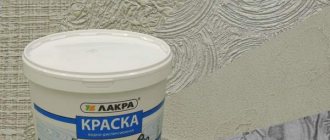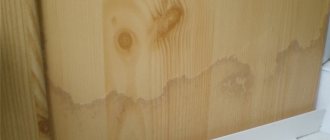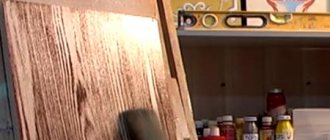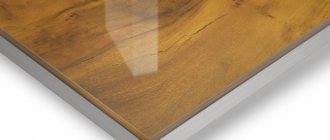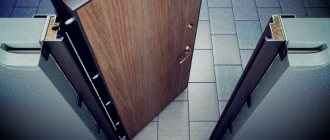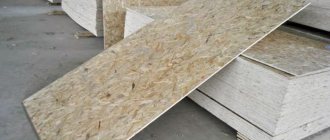Determine previous paint type
Before applying a fresh coat, find out what type of paint is currently on the door. Dampen a rag with alcohol and wipe down her door. If the paint transfers to the fabric, it has been painted with latex paint and no primer will be necessary. If there is nothing left on the rag, you are dealing with oil paint. If you are hoping to use a newer latex one, you will need to sand and then prime the surface.
Another reason to identify the old paint type is health concerns. Until recently, when painting, paints that contain lead were often used, which can be absorbed by the body, which negatively affects internal organs and the brain. This type of paint must be removed from the surface of the door.
Types of paints suitable for interior doors
Today there is a large selection of different paints with which you can paint interior doors.
It can be:
- nitro varnishes, nitro enamels, nitro paints;
- oil paints;
- acrylic;
- alkyd.
There are also safe paints on sale, or eco-paints, which are best suited for painting doors in a nursery. This paint will not have a negative effect on the child’s sensitive body. Although the price of such products is higher than other types of paints, you can be sure that they will not harm the baby’s health. In general, modern paint and varnish products dry quite quickly on surfaces, so after application the pungent odor disappears immediately.
Thus, by painting interior doors, you will not cause discomfort to the residents. Except in cases where someone may develop an allergy during work. Therefore, it is worth checking in advance whether those present have any allergic reactions to the paint.
There are several types of paints:
| Transparent | The composition includes a special pigment that replicates the structure of wood. |
| Opaque formulations | Based on organic solvents. These include: alkyd paint, oil paint, etc. |
| Odorless paints for doors | Such material dries quickly on the surface, without having time to spread a pungent odor. |
Doors made of natural wood are usually treated with nitro paint, which dries quickly. This way you can achieve a practical and durable coating. But nitro paint has a negative quality - it is its sharp, irritating smell. Therefore, when choosing this material, it is best to work outside or at least on the balcony. It is also very important when painting to use a respiratory mask and gloves to protect the skin and respiratory tract.
Take the test
Alkyd paint is currently one of the most popular types of paint and varnish products. This paint can be used to paint almost any surface, and its cost is quite low. But, just as in the case of nitro enamel, when working with alkyd paint, a pungent odor is released, which disappears in about two days. Therefore, you should not paint interior doors indoors, and it is recommended to remove objects that absorb foreign odors well.
You can also use acrylic paint to paint interior doors. This composition is universal for any surface, and it is available on the market in a wide range of colors.
The cost of acrylic paint is higher than the cost of alkyd and nitro paints. But a significant advantage is the absence of odor. Therefore, it is the optimal paint for painting interior doors. However, the acrylic composition is not very durable and wears off the surface quite quickly. Therefore, it is recommended to further strengthen the coating with varnish.
In general, speaking about possible options for covering interior doors, it should be noted that painting is still the most optimal type of finishing. From an aesthetic point of view, a painted door has a beautiful appearance and, taking into account all standards during painting, looks like new. And by choosing the right shade of paint for such a door, you can easily and harmoniously fit it into any interior.
Another advantage of paint and varnish products is their wide color palette. Today, paints are produced in various colors, so you can easily choose any desired shade. In addition, with a certain level of skill, you can create a real work of art from an interior door, turning it, for example, into a portal that opens the way to a forest, an ancient city, and the like.
Also, paint and varnish materials create a durable coating on the interior door. This surface will retain its original appearance for several years, provided that the door has been used with care. But even if you damage some area, you can easily hide the flaw by painting it. But this will not work if the door block was varnished. Here you will need to completely remove the old layer and re-treat the surface.
If there are pets in the house, painting will be the best option for covering interior doors. In practice, it has been observed that cats and dogs do not try to sharpen their claws on a door leaf coated with paint.
As for care, painted interior doors can be easily cleaned with a sponge and water or a mild soap solution. To clean such a surface, you do not need to use special polishes or detergents. Painting work does not take much time and is carried out much faster than, for example, in the case of leatherette or leather upholstery or varnishing.
But, of course, if we are talking about restoration of the canvas, then it will take more time to carefully and carefully paint the door. In addition, if putty was used to restore the surface, then paint can also be used to hide it.
Choose the perfect shade for the slopes
Here's a rule of thumb that designers use: If your door is painted white or another neutral color, make the jambs the same color. If you choose a darker shade, complement it with off-white or neutral trim colors.
If you want to paint the door a darker color, paint the jambs first, let them dry completely for at least 24 hours, protect them with masking tape, then paint the door.
Photography – drivenbydecor
How to paint a wooden door correctly?
When deciding to paint wooden doors with your own hands, you must not forget about the frame. A structure that has different frame and sash colors will look strange. There are two ways to prepare a wooden door for painting:
- The door leaf is removed from its hinges and laid horizontally on a flat table or stools. Cleaning and painting of the sash and frame are carried out separately.
- The door leaf remains hanging on its hinges. After cleaning the sash and frame, it is fixed with wedges in the open state for the duration of painting.
Of the two options, it is better to paint a wooden door at home with the leaf removed. Drips will not appear on a horizontally laid canvas, and it is much easier to clean the old coating. If the fittings are non-removable, use the second option.
Dyeing in the usual way
The usual method of painting means painting a wooden door white or giving it any other shade without the effect of artificial aging. Opaque enamel is used for work. The roller and paint brush are pre-prepared by removing loose bristles with villi.
The painting process in the usual way depends on the design of the door block:
- The panel wooden door is painted with a roller. First, paint is applied to the ends of the sash. Next, roll the roller from the left corner of the upper part of the canvas to the right, and so on across the entire surface. After the first layer has dried, the sash is painted in the longitudinal direction. The second layer is allowed to dry. In the finale, the coloring of the ends and the canvas is repeated from the top corner from left to right.
- A wooden paneled door is painted with a paint brush. First, cover the ends of the sash, figured protrusions and depressions. Further painting of the surface of the canvas occurs according to the scheme used for the panel door.
If the door block needs to be made with an antique effect, use a concentrated stain without coloring enzymes. During impregnation, the solution burns the wood, giving it a gray-brown color. Shades are changed by adjusting the concentration of stain.
When painting with water stain, the door leaf is first moistened. You don't even have to remove the sash. To avoid drips, start painting from the bottom up. The first layer of stain goes along the fibers, the second – across, the third – again along the fibers.
Painting with a water-based stain slightly lifts the wood grain. After the third layer has dried, the surface of the sash is sanded, dust is removed and painted again once. Alcohol stain does not lift fibers. There is no need to sand the blade.
Wood imitation
To beautifully paint a wooden or MDF door, use two opaque enamels on the same base, but with a light and dark shade. The best combination is yellow, beige or gray with brown. First, the door leaf is painted in a light tone. After drying, the product is treated with soap. A layer of brown paint is applied on top. Finally, the soap is washed off with water until the canvas takes on an antique look.
To decorate a wooden or veneered door, brush the surface. After the appearance of soft veneer fibers, an imitation of wood texture appears. One or two coats of paint are applied to the doors, and after drying they are sanded.
Remove the door handle
Spattered paint on a doorknob is a sign of sloppy workmanship. More importantly, moisture in the paint can adversely affect the hardware, potentially clogging the mechanism; Sanding and cleaning agents can also damage internal mechanisms.
To avoid such problems, remove the handle. Use a screwdriver to remove the screws. If you don't see screws, look for a small metal slot on the side of the handle. Then use a pin or paper clip to release the door handle. You can then unscrew the plate that holds the handle in place.
Advantages of stain and varnish
For wood, stain and varnish not only give a beautiful appearance, but also additionally protect the natural material from aging. A combined coating of two components is often used. The stain penetrates deep into the wood, where, together with tannins, it forms a protective barrier against moisture and preserves the natural color of the wood from fading. The varnish creates a decorative shine on the door and also additionally protects it from moisture.
Fill holes and cracks
Painting a door, especially an older one with wood jambs and moldings, usually requires some effort to prepare the surface. Fill all small holes and cracks with putty. Place a small amount of putty or wood filler on a putty knife, fill the gaps with it, and let dry for about two hours.
Photography – drivenbydecor
Recommendations for choosing door colors
The color of the panel is selected based on your wishes. The main recommendations include:
- drying the surface before applying alkyd enamel;
- combination of shade of canvas with furniture;
- choosing a solid wood door coated with oil impregnation for a wooden home;
- combination of an aged door with antique items;
- choosing a dark-tinted door for lacquered furniture;
- use of water-based paints.
During the process of painting a door, you need to follow proper techniques and safety measures.
Treat the surface
Once all imperfections have been filled, cured and sanded, sand the entire surface of the door with 120-grit sandpaper. Wipe the door with a cloth soaked in mineral spirits or use tack cloths to remove dust from the surface. Apply a primer if you are painting the surface with oil-based paint. Once the primer is completely dry (preferably overnight), gently sand the surface again, this time using 220-grit sandpaper.
Photography - bhg.com
How to create imitation wood
To do this you need:
- The canvas is painted with light beige, gray or yellow paint and then dried.
- Using a brush, apply liquid soap to the surface.
- Everything is covered with dark paint, and the soap is washed off.
- If you have a veneered door, you can take note of another method. For this we use a special brush. We walk it through the soft fibers with movements that would resemble combing. The surface is painted with dyes of different colors. The texture will be changed so that the surface will have swirls that resemble wood grain. Sand the surface after it dries.
- If everything is done according to the rules, then even beginners in this business will be able to paint. But first, it’s better to practice a little so that the front side comes out perfectly.
You now know how to touch up a chip on a door and how to paint varnished doors; here it will be important to take your time and properly prepare the surface. And after applying the dye, you won’t have to think about repairing the door for a long time.
Color without interruption
Now that you are ready to start painting, do everything at once without taking a break. If you stop within a coat for even a few minutes, the paint may dry unevenly and cause blemishes. Latex paints can dry and be ready for a second coat in about four hours. Oil paints must dry for 24 hours before applying a second coat. After the first coat has dried, professionals often recommend sanding again using 320-grit sandpaper. Remove any remaining paint dust with a clean cloth and apply a second coat.
Photography - bhg.com
How to remove old stubborn paint from a wooden surface?
To properly paint old wooden doors, first remove the worn-out coating. Clean carefully so as not to disturb the surface of the door leaf. Particular care will be required if you need to repaint a veneered wooden door. The veneer is very thin and is susceptible to mechanical stress. There are four common methods for removing old paint from wooden surfaces.
Mechanical
The most labor-intensive and aggressive mechanical method is used when other methods of removing paint from a wooden surface have not brought a positive result. Veneered doors are not subjected to such cleaning. Mechanically, durable nitro paints and alkyd enamels are usually removed. Peeled areas are cleaned with a scraper or spatula. The stubborn paint is removed with a grinder, grinder or drill with grinding attachments. It is difficult to rub with sandpaper. It is usually used if there is no power tool.
Sandblasting Applications
The mechanical cleaning method includes the use of sandblasting. Air supplied under high pressure from the compressor mixes with dry sand particles and breaks the old paint with a strong jet pressure. Sandblasting can easily remove varnish or enamel from a wooden door in a few minutes, but it is important not to overdo it. The impact of grains of sand crushes the wood along with the paint. If you stay in one place for a long time, the surface will be damaged. To remove a thin layer of paint, use a fine abrasive: river sand or soda.
Heat treatment
The panel and panel doors are subjected to heat treatment. For a safe method of removing paint, use a heat gun or a hair dryer powered by electricity. When heated, the old coating acquires a soft structure that can be easily scraped off with a scraper. Professionals use gas torches, but work with such tools carefully. An open source of fire along with paint can burn the wood.
Chemical method
To remove paint from doors chemically, use solutions that soften most types of enamels and varnishes. The work is performed in a well-ventilated area using personal protective equipment. The method is suitable for veneered door panels, but first you need to check the instructions to see if the solution is safe for veneer.
To remove old paint from a wooden door, just lubricate it with a chemical. After 5–10 minutes, the coating will rise in bubbles that can be easily removed with a scraper.
Painting paneled doors
The basic method for painting a flat door is with long, smooth strokes or vertical strokes with a roller. But panel doors are often installed, which must be painted in the following order:
- First paint the ends of the door;
- Next, paint the inner rectangular panels;
- Then paint the vertical stripe between the panels;
- Let's move on to horizontal stripes;
- Move on to paint the edges of the door.
Photography – make-self
Painting veneered fabric
A wooden door covered with veneer cannot be painted with compounds based on aggressive solvents. First of all, this applies to nitro paint. Due to chemical exposure, matte spots will appear on the veneer. It is better to choose water-based, glyphthalic or polyurethane-based tinted varnishes.
To paint a varnished veneered wooden door, the surface is cleaned using a special floor solution. After removing the old varnish, the veneer is primed, and when dry, it is painted.
It is necessary to renew the entire wooden door block if the coating is damaged over a large area. It is easier to wipe out small scratches by matching the color of paint or varnish.
Speed up drying time
To minimize drying time, apply the paint in good light, being careful not to create a thick layer that takes longer to dry and can end up looking uneven. If using a brush, dip the bristles halfway into the paint, then lightly tap the edge of the tray to remove excess. When using a roller, place it in a special tray so that the paint is evenly distributed over the surface of the roller.
Tip: After painting, turn on a fan or open windows to increase air flow. In hot and humid climates, run a dehumidifier if possible.
How to varnish a wooden door?
Opaque enamels completely hide the color and texture of wood. To preserve the natural texture, you can paint the door with varnish on an alkyd, acrylic or other base.
A transparent coating is optimal for a new canvas. Stain will help hide defects on old wood. After saturating the surface, apply two layers of transparent varnish in different directions. Drying takes longer than the enamel requires. Moreover, each layer must dry separately.
Using stain, you can paint wooden doors in wenge color, and top them with varnish. Sometimes they practice the use of roasting. A gas burner will help you achieve the wenge color. The wood is burned with an open flame to a dark brown hue. After sanding, even a pine board cannot be distinguished from wenge by its texture. The finished canvas is treated with a protective impregnation, and after drying it is coated with a transparent varnish.
Painting a wooden door with any paint and varnish material is available at home. You just need to strictly follow the technology.
